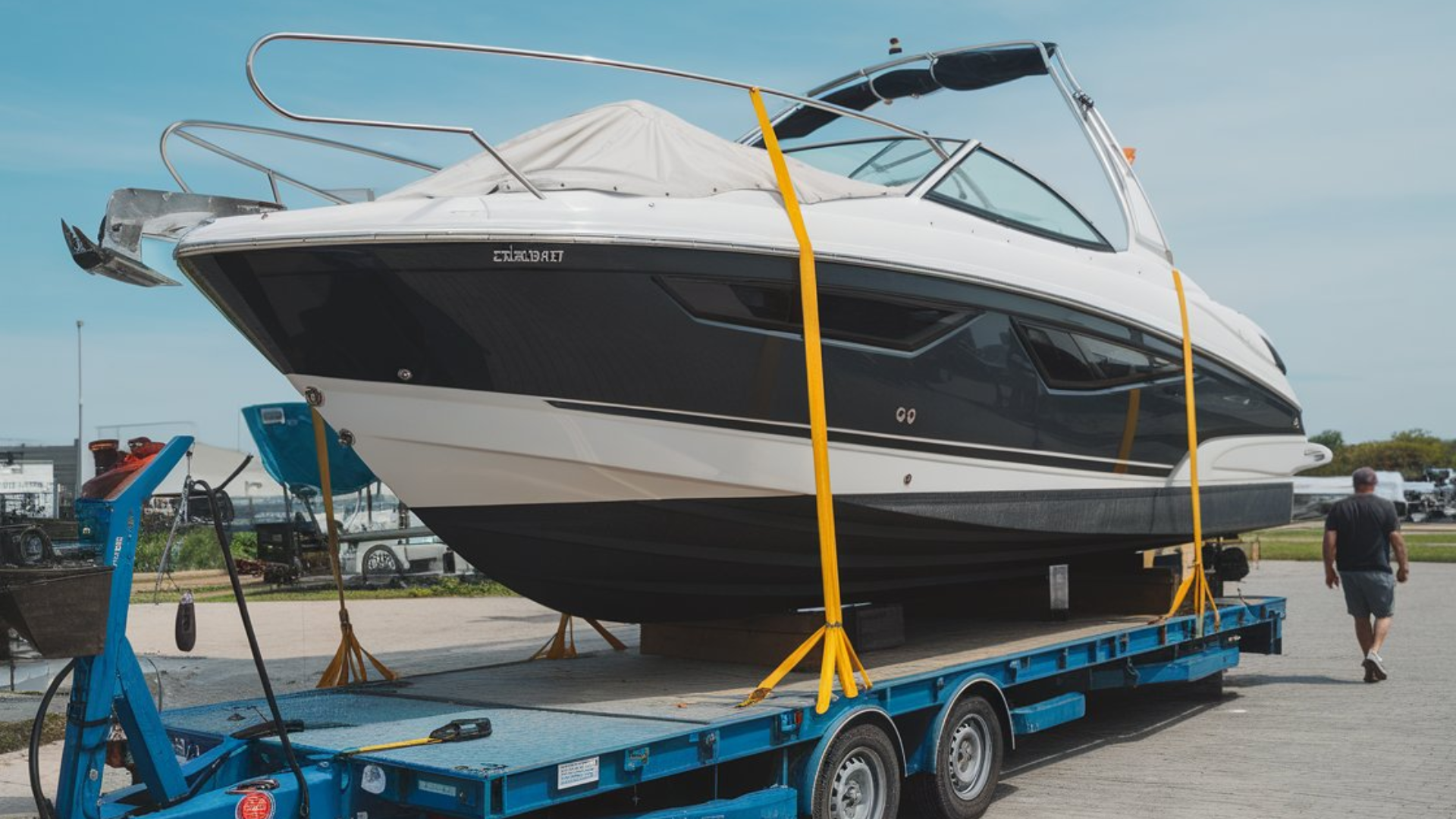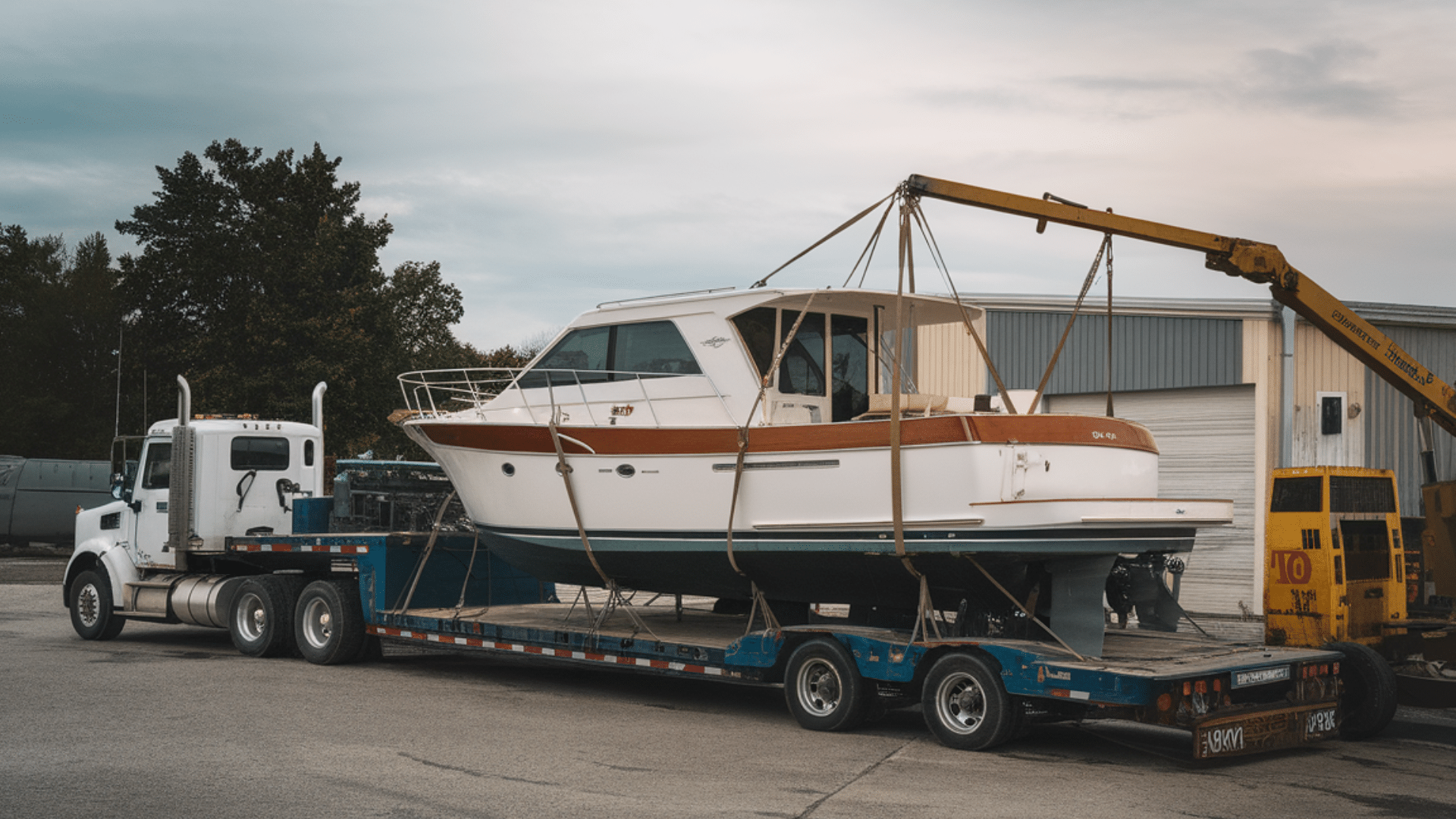I know how confusing it can be to figure out the real cost of transporting a boat across the country. When I first looked into it, I had no idea how many details played a role in the price.
It’s not just about distance – things like size, weight, permits, and even the season can change the final number. That’s why understanding the average boat transport cost and cost per mile is so helpful.
In this guide, I’ll break down the basics, share what usually affects the boat transport cost, and give you tips to plan ahead.
With the right information, you can budget better and avoid surprises when it’s time to move your boat.
How Does Boat Transportation Work?

Boat transportation is the process of moving a boat from one place to another, usually by land on a special trailer or truck.
It starts with choosing a professional hauler who has the right equipment for your boat’s size and weight.
Before pickup, the boat is prepared by removing loose items, lowering towers or masts, and sometimes shrink wrapping it for protection.
At the marina or storage yard, a lift or crane may be used to place the boat on the trailer. The hauler then secures it carefully and begins the trip. Along the way, permits or escorts may be needed for oversize boats.
Once delivered, the boat is offloaded and checked to make sure everything arrived safely.
Average Boat Transport Cost Per Mile
When you’re planning to move your boat, knowing the average costs can help you budget smartly.
Per-mile costs usually range from $1.50 to $4.00, depending on boat size and distance.
- Smaller or trailerable boats (under 500 miles): $1.50–$2.50 per mile
- Longer hauls (1,000+ miles): $1.50–$3.00 per mile
Common estimates for a 28–40 ft boat run about $1.50–$3.50 per mile, though some routes and seasons push it higher.
Season and route matter – spring/summer tends to hike prices, while longer hauls may drop per-mile costs.
Fixed-rate examples:
- A 20‑ft fishing boat (~3,000 lb): $1.50–$2.00 per mile → 500-mile haul = $750–$1,000
- A 30‑ft powerboat: $2.00–$2.50 per mile → 300 miles = $600–$750
Boat Transport Cost Per Mile: How It’s Calculated
The cost of moving a boat isn’t random; it’s based on a mix of important factors. Most companies start with a per-mile rate, then adjust it for your boat’s details and the route.
- Distance of the trip: Longer trips often have a lower cost per mile compared to short hauls.
- Boat size and weight: Wider, taller, or heavier boats may need special trailers, permits, or even escort vehicles.
- Route and permits: Some states require extra permits or pilot cars if the boat is oversize, which adds to the cost.
- Season and fuel prices: Busy months and higher fuel costs can raise per-mile rates.
By knowing these factors, you’ll understand why quotes can vary and how to spot a fair price.
Factors Affecting Boat Transport Cost

When planning to move a boat, the final price depends on more than just distance.
- Size and Weight of the Boat: Larger or heavier boats often need special trailers, cranes, or pilot cars, which increases the cost.
- Distance and Route: Longer trips can lower the per-mile rate, but tolls, bridges, or difficult routes can add extra fees.
- Permits and Regulations: Oversized boats may require state permits or escorts, and these costs vary by location.
- Marina and Handling Fees: Haul-out, launch, and storage charges at marinas are usually billed per foot.
- Season and Demand: Summer and spring are busy seasons, so prices are often higher compared to fall or winter.
Understanding these factors makes it easier to budget and compare quotes.
Boat Transport Cost: Land, Captain Delivery, and Sea Freight
There’s more than one way to move a boat, and each method comes with its own costs, pros, and cons. Knowing the differences helps you choose the best fit for your budget and needs.
| Transport Method | Average Cost Basis | Best For | Pros | Cons |
|---|---|---|---|---|
| Overland Hauling | $1.50–$4.00 per mile | Trailerable to mid-size boats | Often cheapest per mile, flexible | Size limits, permits needed |
| Captain Delivery | Daily/weekly crew + fuel | Boats seaworthy for the whole trip | No trailer needed, direct delivery | Weather delays, fuel & wear/tear |
| Sea Freight | By foot or cubic meter | Large yachts, international transport | Handles very large vessels | Expensive, complex logistics |
Each option fits a different situation. By weighing costs against convenience and safety, you can pick the method that makes the most sense for your boat and budget.
Understanding the Process of Boat Transportation
Transporting a boat involves several important steps, and each one plays a role in the overall cost and safety.
1. Getting an Accurate Quote
The process starts with requesting quotes from professional haulers.
To get the most accurate price, you’ll need to provide details such as the boat’s length, width, height, weight, pickup and delivery locations, and preferred timing.
Carriers use this information to calculate the cost per mile and determine if permits or escorts are needed.
2. Preparing the Boat for Transport
Before pickup, the boat must be prepared to travel safely.
This often means removing personal items, securing hatches, lowering antennas, towers, or masts, and sometimes shrink wrapping the hull for protection.
Proper preparation prevents damage and avoids delays during loading.
3. Haul-Out and Loading at the Marina
If the boat is in the water, a marina or boatyard will use a travel lift or crane to haul it out. The boat is then set on a specialized trailer that matches its size and weight.
Loading correctly is crucial to keeping the boat stable during transport.
4. Overland Transport and Route Management
Once secured, the hauler transports the boat along the planned route. For oversize boats, special permits may be required, and some states mandate escort vehicles.
The driver monitors the load throughout the trip to ensure it stays secure.
5. Delivery, Launch, and Final Inspection
At the destination, the boat is offloaded using a lift or crane if needed. The hauler and owner inspect the vessel to make sure it arrived in good condition.
Any protective wrapping is removed, and the boat can then be launched back into the water or placed in storage.
Prep Tips to Avoid Extra Boat Transport Fees
Getting your boat ready the right way can save you from surprise charges and keep the trip stress-free.
- Measure Accurately: Know the boat’s true length, width, and height, including trailers, towers, and antennas. Wrong details can trigger re-quotes or permit issues.
- Remove or Secure Loose Gear: Take off electronics, canvas, and personal items. Extra weight or shifting gear can cause damage and higher costs.
- Lower Masts and Towers: Folding or removing tall parts helps you avoid oversize fees and makes the move smoother.
- Protect the Boat: Use shrink wrap or padding for long-distance hauls to prevent scratches and road debris damage.
- Book Marina Services Early: Schedule haul-out and launch ahead of time to lock in better rates and avoid last-minute charges.
With these simple steps, you’ll keep costs predictable while making sure your boat arrives safely.
Conclusion
Moving a boat across the country takes planning, but it doesn’t have to be overwhelming.
The biggest factor in cost is usually the size of your boat and the distance it needs to travel, though permits, marina fees, and timing also play a role.
By understanding how boat transport cost per mile is calculated, you can compare quotes confidently and avoid paying more than necessary.
I’ve found that preparing the boat carefully and asking the right questions makes the process far smoother.
If you want more practical insights on shipping, transport, and logistics, read my other blogs for guides that help you plan smarter and avoid surprises.















